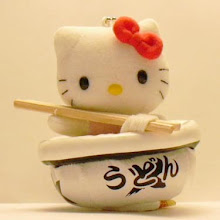Summer is here: Part I
Since we’re about to head into the “dog-days” of summer here in the States, I thought this would be the perfect time to introduce the Limited and Regional Kitties that represent the various summer festivals and customs in Japan.
LIMITED VERSION: “SUMMER – SUIKA” 2003

Nothing says summer like the beach and a bit of “smash-the-watermelon” or more precisely, suikawari – the watermelon splitting game. Kitty is blindfolded and her goal is to crack open that juicy watermelon with just that stick. Wish her luck because the beach natives are getting hungry!
LIMITED VERSION: “SUMMER – HANABI” 2003

Its another hot summer night, but that doesn’t stop Kitty from going out to see the fireworks. To make sure she’d be comfortable, she donned her yukata and brought her uchiwa fan. Yukatas are casual, lightweight cotton kimonos. During the summer, many women and young girls wear beautifully colored/patterned yukatas for festival and firework events.
LIMITED VERSION: “SUMMER – SENKO HANABI” 2003

In this netsuke version, Kitty holds a senko hanabi (an incense stick-sparkler) for a more home-style fireworks show. Once all the grown-ups have safely fired off the rockets and firecrackers, Kitty gets to hold a senko hanabi. Once its lighted Kitty must be careful not to shake the stick or her small fireworks show will go out too soon!
* In the plush version, Kitty holds something that looks like a little toy pig. At first I thought it was another toy firework but I could not find any references to it. My sympathetic Kitty contact kindly explained what it really was: a porcelain pig that is often used to hold a burning mosquito coil. I guess Kitty doesn’t want to take any chances with encephalitis. Smart cat.

["Katori Buto" - a nice 3D depiction that I found at the this website]
LIMITED VERSION: “SUMMER – KINGYO” 2003

Another item synonymous with summer is goldfish. Goldfish are symbols of good fortune, prosperity, harmony and beauty. They are also an integral part of summer festival activities, both as games and prizes.
In part II I will cover some of the festival events including the goldfish games and "yomise" -- the special stalls that surround the summer firework events.

Nothing says summer like the beach and a bit of “smash-the-watermelon” or more precisely, suikawari – the watermelon splitting game. Kitty is blindfolded and her goal is to crack open that juicy watermelon with just that stick. Wish her luck because the beach natives are getting hungry!

Its another hot summer night, but that doesn’t stop Kitty from going out to see the fireworks. To make sure she’d be comfortable, she donned her yukata and brought her uchiwa fan. Yukatas are casual, lightweight cotton kimonos. During the summer, many women and young girls wear beautifully colored/patterned yukatas for festival and firework events.

In this netsuke version, Kitty holds a senko hanabi (an incense stick-sparkler) for a more home-style fireworks show. Once all the grown-ups have safely fired off the rockets and firecrackers, Kitty gets to hold a senko hanabi. Once its lighted Kitty must be careful not to shake the stick or her small fireworks show will go out too soon!
* In the plush version, Kitty holds something that looks like a little toy pig. At first I thought it was another toy firework but I could not find any references to it. My sympathetic Kitty contact kindly explained what it really was: a porcelain pig that is often used to hold a burning mosquito coil. I guess Kitty doesn’t want to take any chances with encephalitis. Smart cat.

["Katori Buto" - a nice 3D depiction that I found at the this website]

Another item synonymous with summer is goldfish. Goldfish are symbols of good fortune, prosperity, harmony and beauty. They are also an integral part of summer festival activities, both as games and prizes.
In part II I will cover some of the festival events including the goldfish games and "yomise" -- the special stalls that surround the summer firework events.















